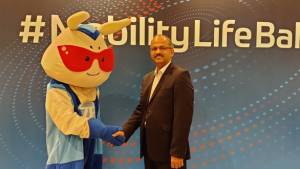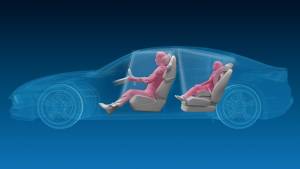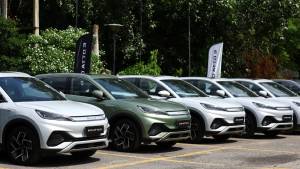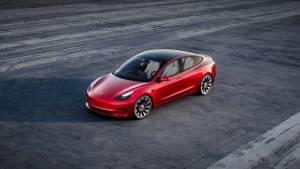ZF demonstrates future driving assists through the Smart Urban Vehicle
German component manufacturer, ZF, unveiled a concept car that represents the future of driver assistant technologies. It could even find its way into the passenger cars of tomorrow. The ZF SUV (Smart Urban Vehicle, mind you, not Sport Utility Vehicle) is a game-changing concept in the field of driver assistance. It was built entirely in-house using a standard hatchback as a base.
The SUV is powered by a traction battery which drives a semi-independent rear suspension called eTB (electric Twist Beam) which propels the wheels using a compact drive unit located on both rear wheels. Each drive unit produces 40kW of power, 1,400Nm of axle torque and a maximum of 21,000rpm, giving the car a claimed top speed of 150kmph. Another remarkable feat ZF has accomplished is giving the SUV a turning diameter of less than seven meters through 75 degree steering angles. This in turn is supported by a torque vectoring system in the rear wheels that distributes power to each wheel individually and hence improves manoeuvrability especially in those tight spots.
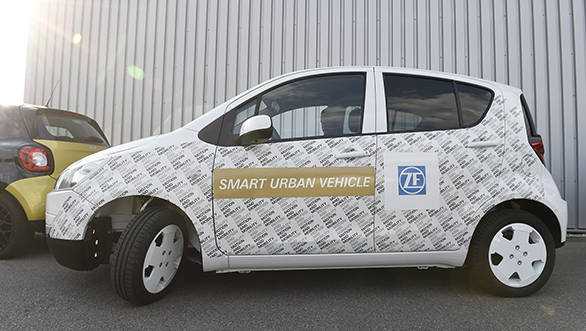
One of the driver assistance systems offered on this car is a feature called Smart Parking Assist. The system not only recognises suitable parking spaces, but can also park the car itself using 12 ultrasound sensors and two infrared sensors that are distributed around the car. The driver can communicate with the car throughout the process using a smart device such as a smart watch.
However, one of the most interesting features it supports is the PreVision Cloud Assist. This system takes into account geometric data, information on legal speed limits and also stores data in the cloud regarding current driving speed, vehicle position, along with lateral and longitudinal acceleration. If the driver uses the same route regularly, it analyses it and calculates the optimum speed for approaching curves and cuts back on the torque early enough to ensure that mechanical braking is not required. All these features not only provide safety but also protect the car's braking system and battery. This system is linked to an organic LED display unit in the steering wheel's rim which informs the driver about the drop or increase in torque around bends.
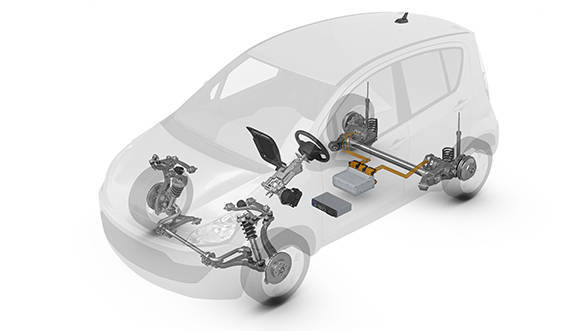
The SUV also features a hands-on detection (HOD) system that uses a capacitive system. It covers the whole steering wheel and detects whether or not the driver is holding the wheel. The system then converts this information into digital signals and sends it to the vehicle using the Local Interconnect Network (LIN) and depending on the circumstances, it alerts the driver or initiates appropriate safety measures.
While all this technology might not thrill all the motoring enthusiasts that prefer to be in control of the car themselves, one has to remember that this technology is not aimed at them. It is developed for regular people driving in crowded cities with dwindling parking spaces. For those tight stretches and corners, this is the kind of technology that will add to the 'pros' checklist when making a buying decision.
Big in the City: The ZF Smart Urban Vehicle
| _ Maneuverability in urban traffic thanks to innovative frontaxle concept and electric motors mounted close to the wheel _ Semi-automated assistance functions enhance comfort/convenience, safety, and efficiency _ Innovative multifunction steering wheel with hands-on detection (HOD) and organic light-emitting diode (OLED) display _ Concept vehicle produced entirely in-house Extremely maneuverable, locally emission-free, and networked with driver and environment: With the Smart Urban Vehicle, ZF is demonstrating the potential inherent in intelligently networking individual chassis/driveline and driver assistance systems, and is presenting an exemplary solution for urban individual transport in the compact and subcompact segments. The all-electric rear-axle drive eTB (electric Twist Beam), which is mounted close to the wheel, lies at the heart of the vehicle concept. This drive enables the basic layout of the Smart Urban Vehicle to be redesigned. The front axle is also highly innovative, with steering angles of up to 75 degrees enormously increasing the agility and maneuverability of the prototype. Two semiautomated driver assistance functions provide additional comfort/convenience as well as safety and efficiency: Smart Parking Assist maneuvers the vehicle into virtually any small parking space remote-controlled at the push of a button using mobile devices such as a smartphone or smartwatch. Comfortable, efficient motoring is possible with the concept vehicle thanks to the cloud-based PreVision Cloud Assist assistance function. Where necessary, the system reduces the drive torque, for instance, in good time before entering the bend and thus throttles back the speed without any mechanical braking. The driver is also in direct contact with the Smart Urban Vehicle via the steering wheel: The hands-on detection function covers the entire steering wheel and thus forms the basis for assistance and automated driving functions. An OLED display in the driver's direct field of view provides the driver with additional information. "With the Smart Urban Vehicle, ZF is demonstrating the kinds of specific solutions that are already feasible for urban individual transport by networking existing technologies and systems in the vehicle, having these functions interact with the driver, with the driver's behavior, and with the environment, or by accessing data which can be provided anywhere thanks to cloud connectivity," explains Dr. Stefan Sommer, Chief Executive Officer of ZF Friedrichshafen AG. "At the same time, this study also marks to a certain extent a starting point from which concepts for future urban mobility can be derived very specifically also with regard to the new competency areas opening up for ZF thanks to the acquisition of TRW." Built from scratch ZF is presenting an electric vehicle in the shape of the Smart Urban Vehicle, which was built entirely in-house on the basis of a standard subcompact car. The concept vehicle obtains its power from a traction battery, which is housed in three modules altogether on the front and rear axle. ZF's semi-independent rear suspension eTB (electric Twist Beam) provides the propulsion courtesy of a compact drive unit located on the left and right wheel respectively, each of which produces 40 kilowatts. With axle torque of 1,400 Nm and a maximum 21,000 revolutions per minute, the vehicle, which is tailored to urban traffic, reaches a top speed of 150 kilometers per hour. Maneuverable through town "At the front axle, we have implemented a new concept with steering angles of up to 75 degrees," explains Dr. Harald Naunheimer, Head of Corporate Research and Development at ZF Friedrichshafen AG. The innovative chassis concept thus reduces the steering effort substantially during parking and turning maneuvers, and, in turn, increases the maneuverability of a Page 3/7, July 3, 2015 subcompact car in particular: Thanks to the modified wheel deflection, the turning circle diameter of the Smart Urban Vehicle is reduced to under seven meters a U-turn, in other words turning through 180 degrees, is possible with no difficulty on a standard two-lane road. The steering movements at the front axle are supported by the torque vectoring system of the rear-axle drive, which distributes the drive force individually to the two rear wheels and enables the vehicle to move off with this kind of large wheel deflection. Hence the concept vehicle can also be maneuvered with ease into extremely small parking spaces. Recognized, pressed, parked: The ZF Smart Parking Assist The advantages of the new front-axle concept come to the fore in combination with the Smart Parking Assist driver assistance function implemented in the Smart Urban Vehicle. The system assists the driver not only in recognizing suitable parking spaces, but can also park the vehicle fully automatically in parallel or perpendicular spaces. The parking aid obtains its information from twelve ultrasound sensors and two infrared sensors on the vehicle's front-end, rear-end, and flanks; these sensors help find a suitable parking space. The control electronics process the information and control all the systems involved in the parking function for instance, the electric drive and the required steering angle of the electric power steering. The driver can interact with the vehicle during the process via the display in the cockpit or trigger the parking function once they exit the vehicle by using an application on a mobile device, e.g. a smartwatch. The Smart Urban Vehicle then automatically searches the surroundings at walking pace for a suitable gap and automatically initiates the parking process. Enhances comfort for the driver, relieves pressure on cities For the future, the Smart Parking Assist opens up potential scenarios which provide additional benefits for the driver: The driver can get out at the destination, leaving the vehicle to head off autonomously for a parking garage, thus saving valuable time in the process. "When implementing the concept, we weren't only Page 4/7, July 3, 2015 looking at the benefits for the driver," explains Harald Naunheimer. "If passenger cars in future park without a driver, parking space can also be used more effectively. As such the door opening angles would no longer need to be taken into account in the parking garage thus making the parking spaces smaller. All of which also takes the pressure off cities because the freed-up space can then be used productively as additional living and working areas." Driver experience from the cloud The cloud-based ZF PreVision Cloud Assist driver assistance function provides maximum range and driving safety in the Smart Urban Vehicle. Unlike purely GPS-based systems, the ZF study not only takes into account geometry data and information on the permissible top speed, but also stores data in the cloud on the vehicle position, currently driven speed, and lateral and longitudinal acceleration for every journey. If the driver follows the same route again, the system calculates the optimum speed for an approaching bend on the basis of these empirical data and actual vehicle data. The assistance function then throttles back the torque early on before entering the bend, to the point where the bend can be negotiated without any mechanical braking. All of which not only protects the vehicle's battery and braking system, but also provides greater safety particularly on blind corners. Communication via the steering wheel The driver is kept informed at all times about the intervention of PreVision Cloud Assist: The multifunction steering wheel, which ZF uses in the Smart Urban Vehicle, features an OLED display in the steering wheel rim in the driver's direct field of view. This display shows, for instance, how much drive torque the driver assistance system throttles back before entering the bend or provides again after the bend. The driver, however, remains in direct contact with the Smart Urban Vehicle using HOD. The capacitive system covers the entire steering wheel and detects whether the driver is holding the Page 5/7, July 3, 2015 steering wheel. The electronic control unit built into the steering wheel converts the identified state into a digital signal and sends this to the vehicle via the LIN (Local Interconnect Network). Depending on the situation, this alerts the driver or activates the available assistance systems. "With the hands-on detection, we are creating the basis for assistance and automated driving functions which reduce the driver's workload such as in urban traffic, which is characterized by strenuous stop-and-go phases during rush-hour periods," explains Dr. Alois Seewald, Technical Director of Integrated Active & Passive Safety Technologies at ZF TRW. These assistance functions automatically maintain, for instance, a sufficient distance to the vehicle ahead or reliably initiate braking as required. "Thus we can improve active safety even if the driver does not have their hands on the steering wheel." | |
Related Stories
Top Stories
Latest Videos
Most Popular
- Budget Sportbike Showdown: Kawasaki Ninja 500 vs Aprilia RS 457 vs Yamaha YZF-R3
- Mumbai-Pune Expressway speed restrictions updated
- 2014 Triumph Daytona 675 vs 2024 Kawasaki ZX6R - A Decade of Evolution in Supersport Motorcycles
- Upcoming Mahindra XUV 3XO: All you need to know
- 2024 Hyundai Creta vs Toyota Urban Cruiser Hyryder vs Skoda Kushaq comparison review - the hype is real?

